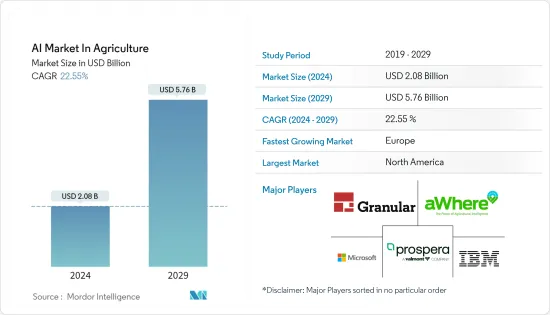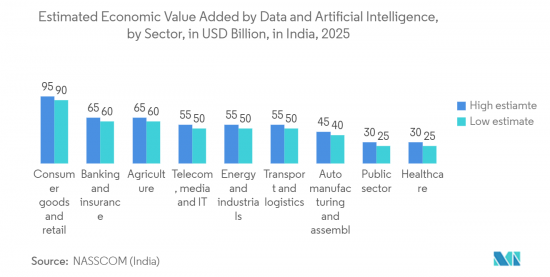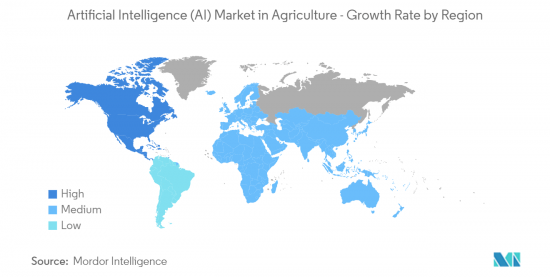 |
市場調查報告書
商品編碼
1430559
農業人工智慧:市場佔有率分析、產業趨勢與統計、成長預測(2024-2029)AI In Agriculture - Market Share Analysis, Industry Trends & Statistics, Growth Forecasts (2024 - 2029) |
||||||
價格
※ 本網頁內容可能與最新版本有所差異。詳細情況請與我們聯繫。
簡介目錄
農業人工智慧市場預計將從2024年的20.8億美元成長到2029年的57.6億美元,預測期內(2024-2029年)複合年成長率為22.55%。

因為這些曳引機使用基於 GPS 的技術來自動駕駛、從地面舉起工具、識別農場邊界,並且可以使用平板電腦進行遠端控制。小型自動駕駛曳引機有潛力為農民增加10%以上的收益,並降低農場人事費用。
主要亮點
- 利用機器學習技術實現作物產量最大化正在推動市場發展。品種選擇是一個費力的過程,需要尋找決定水和養分利用效率、適應氣候變遷、抗病性、營養成分和更好口味的特定基因。機器學習,特別是深度學習演算法,需要數十年的現場資料來分析各種氣候下的作物表現。基於這些資料,可以建立機率模型來預測哪些基因最有可能賦予植物有益的性狀。
- 牛臉部辨識技術的日益採用正在推動市場發展。透過應用先進的指標,如牛臉部辨識程序和影像分類,結合身體狀況評分和餵食模式,酪農現在可以獨立監控牛群的所有行為方面。
- 無人機在農業中的應用可用於使用小型多頻譜成像感測器掃描作物、使用機載攝影機創建 GPS 地圖、運輸重物、使用配備熱感成像相機的無人機監控牲畜等。無人機(UAV)的使用在世界範圍內不斷增加,從而增加了對無人機的需求。
- 然而,對資料收集和資料共用標準化的需求很高,限制了市場的成長。機器學習、人工智慧和先進演算法設計正在迅速發展,但有意義的、標記良好的農業資料的收集卻落後了。
- COVID-19對AI農業市場的整體影響是正面的。此次疫情成為產業創新和數位轉型的催化劑,刺激採用人工智慧主導的解決方案來提高效率、生產力和永續性。遠端監控和管理的需求加速了農業流程的數位化。用於資料分析、預測建模和智慧農業的人工智慧主導工具對於最佳化生產、減少廢棄物和確保糧食安全至關重要。
農業人工智慧 (AI) 市場趨勢
無人機分析應用/細分市場預計將佔據很大的市場佔有率
- 無人機分析和人工智慧在農業中的整合為最佳化農業營運、降低成本和增強永續性提供了巨大潛力。透過利用人工智慧的力量分析無人機捕獲的資料,農民可以做出資料驅動的決策,改善資源配置並實現更高的生產力。因此,無人機分析預計將成為農業市場人工智慧的關鍵驅動力。
- 無人機配備高解析度攝影機和感測器,可以捕獲有關作物、土壤狀況和田間特徵的大量資料。與人工智慧驅動的分析相結合,這些資料為農民提供了有關作物健康、營養水平、蟲害以及其他影響農業生產力的因素的寶貴見解。
- 人工智慧驅動的無人機分析透過提供田地內特定區域的詳細資訊來實現精密農業實踐。透過使用人工智慧演算法分析無人機資料,農民可以識別作物生長、土壤濕度水平和害蟲種群的變化。這使得有針對性的干涉成為可能,例如精確施肥、殺蟲劑和散佈,從而最佳化資源利用並提高產量。
- 配備人工智慧分析功能的無人機可以監測作物的整個生長階段。透過分析無人機影像和感測器資料,人工智慧演算法可以檢測植物壓力、疾病爆發和營養缺乏的早期徵兆。然後,農民可以採取積極措施,例如調整灌溉、採用適當的處理方法以及實施預防措施,以降低風險並最佳化作物健康。
- 人工智慧驅動的無人機分析使農民能夠有效地監控大片農田。人工智慧演算法可以自動分析無人機捕獲的資料並識別需要注意的區域,而不是耗時的手動檢查。這簡化了操作,降低了人事費用,並使農民能夠根據準確、及時的資訊做出決策。 NASSCOM 預計,到 2025 年,資料和人工智慧技術將為印度農業部門付加約 900 億美元的收入。總體而言,到 2025 年,人工智慧預計將為印度 GDP 增加約 5,000 億美元。

預計北美將佔據較大市場佔有率
- 北美農業人工智慧市場是更大的農業技術產業的重要組成部分。北美農業人工智慧市場正在經歷顯著成長。由於農業領域擴大採用人工智慧技術,預計未來幾年該市場將大幅擴大。提高生產力的需求、對精密農業技術的需求不斷成長以及先進基礎設施的可用性等因素正在促進市場成長。
- 北美農民和農業企業正在採用人工智慧技術來提高效率、最佳化資源配置並增強決策流程。該地區農業產業的人工智慧應用包括精密農業、遙感、作物監測、預測分析和自動化農業系統。這些技術幫助農民做出資料驅動的決策,以提高產量、降低成本和風險。
- 技術供應商、相關企業、研究機構和新興企業之間的合作是北美農業人工智慧市場的特徵。這些合作將促進創新並開發適合該地區農業部門獨特需求的人工智慧主導解決方案。對人工智慧新興企業的合作和投資進一步促進了市場成長和技術進步。
- 北美各國政府正在認知到人工智慧在農業中的潛力,並正在實施支持性政策和措施。這包括資助計劃、研究津貼、法律規範,以加速人工智慧在農業中的採用和創新。這些舉措為人工智慧市場的成長提供了有利的環境,並促進永續和有彈性的農業實踐的發展。
- 2023 年 1 月,美國和歐盟 (EU) 建立合作關係,透過使用人工智慧 (AI) 改善農業、氣候預測、緊急應變和電網。這項合作目前正在歐盟委員會和 27 個歐盟 (EU) 執行機構白宮之間進行。

農業人工智慧(AI)產業概況
- 農業人工智慧(AI)市場由微軟公司、IBM公司、Granular Inc.、aWhere Inc.和Prospera Technologies Ltd.等主要企業瓜分。市場參與者正在採取聯盟、合作和收購等策略來加強其產品供應並獲得永續的競爭優勢。
- 2023 年 4 月,IBM 和 Texas A&M AgriLife 聯手為農民提供消費量見解,從而提高農業生產力並降低經濟和環境成本。 Texas A&M AgriLife 和 IBM 將部署和發展 Liquid Prep,這是一種技術解決方案,可幫助美國乾旱地區的農民確定何時澆水。
- 2022 年 5 月,AGRA 和微軟擴大合作,支持農業數位轉型。 AGRA 和微軟在達沃斯簽署了一份關於透過非洲轉型辦公室未來合作的合作備忘錄。兩個組織都將利用 2019 年啟動的合作夥伴關係所取得的成功,該合作關係促成了 AgriBot 的開發。
其他福利
- Excel 格式的市場預測 (ME) 表
- 3 個月的分析師支持
目錄
第1章簡介
- 研究假設和市場定義
- 調查範圍
第2章調查方法
第3章執行摘要
第4章市場洞察
- 市場概況
- 產業價值鏈分析
- 產業吸引力-波特五力分析
- 買家/消費者的議價能力
- 供應商的議價能力
- 新進入者的威脅
- 替代品的威脅
- 競爭公司之間敵對關係的強度
- COVID-19對農業人工智慧(AI)市場的影響分析
第5章市場動態
- 市場促進因素
- 利用機器學習技術最大化作物產量
- 牛臉部辨識技術的採用增加
- 農業中無人機 (UAV) 的使用增加
- 市場限制因素
- 資料收集缺乏標準化
第6章市場區隔
- 按用途
- 天氣追蹤
- 精密農業
- 無人機分析
- 按配置
- 雲
- 本地
- 混合
- 按地區
- 北美洲
- 歐洲
- 亞太地區
- 世界其他地區
第7章 競爭形勢
- 公司簡介
- Microsoft Corporation
- IBM Corporation
- Granular Inc.
- aWhere Inc.
- Prospera Technologies Ltd.
- Gamaya SA
- ec2ce
- PrecisionHawk Inc.
- Cainthus Corp.
- Tule Technologies Inc.
第8章投資分析
第9章 市場機會及未來趨勢
簡介目錄
Product Code: 64248
The AI Market In Agriculture Industry is expected to grow from USD 2.08 billion in 2024 to USD 5.76 billion by 2029, at a CAGR of 22.55% during the forecast period (2024-2029).

The driverless tractor is trending in the market, as these tractors can steer automatically using GPS-based technology, lift tools from the ground, recognize the boundaries of a farm, and be operated remotely using a tablet. A fleet of smaller automated tractors could raise farmer revenue by more than 10 percent and reduce farm labor costs.
Key Highlights
- Maximizing crop yield using machine learning techniques is driving the market. Species selection is a tedious process of searching for specific genes that determine water and nutrient use effectiveness, adaptation to climate change, disease resistance, nutrient content, or a better taste. Machine learning, in particular deep learning algorithms, takes decades of field data to analyze crop performance in various climates. Based on this data, one can build a probability model to predict which genes will most likely contribute a beneficial trait to a plant.
- An increase in the adoption of cattle face recognition technology is driving the market. By applying advanced metrics, including cattle facial recognition programs and image classification incorporated with body condition scores and feeding patterns, dairy farms can now individually monitor all behavioral aspects of a group of cattle.
- The increased use of unmanned aerial vehicles (UAVs) across agricultural farms is driving the market, as the use of drones in the agriculture industry can be used in crop field scanning with compact multispectral imaging sensors, GPS map creation through onboard cameras, heavy payload transportation, and livestock monitoring with thermal-imaging camera-equipped drones, which increases the demand for UAVs.
- However, the need for standardization is restraining market growth as the need for data collection and data sharing standards is high. Machine learning, artificial intelligence, and advanced algorithm design have moved quickly, but collecting well-tagged, meaningful agricultural data is way behind.
- The overall impact of COVID-19 on the AI agriculture market was positive. The pandemic acted as a catalyst for innovation and digital transformation in the industry, driving the adoption of AI-driven solutions for increased efficiency, productivity, and sustainability. The need for remote monitoring and management accelerated the digitization of agricultural processes. AI-driven tools for data analysis, predictive modeling, and smart farming have become essential for optimizing production, reducing waste, and ensuring food security.
Artificial Intelligence (AI) in Agriculture Market Trends
Drone Analytics Application Segment is Expected to Hold Significant Market Share
- Integrating drone analytics and AI in agriculture offers tremendous potential for optimizing agricultural operations, reducing costs, and enhancing sustainability. By leveraging the power of AI to analyze drone-captured data, farmers can make data-driven decisions, improve resource allocation, and achieve higher productivity. Therefore, drone analytics is expected to be a significant driver of the AI market in agriculture.
- Drones with high-resolution cameras and sensors can capture vast amounts of data about crops, soil conditions, and field characteristics. Combined with AI-powered analytics, this data enables farmers to gain valuable insights into crop health, nutrient levels, pest infestations, and other factors influencing agricultural productivity.
- AI-powered drone analytics enable precision agriculture practices by providing detailed information about specific areas within a field. By using AI algorithms to analyze drone-captured data, farmers can identify variations in crop growth, soil moisture levels, or pest populations. This allows for targeted interventions, such as precise fertilizers, pesticides, or irrigation applications, leading to optimized resource utilization and increased crop yields.
- Drones equipped with AI-enabled analytics can monitor crops throughout their growth stages. By analyzing drone imagery and sensor data, AI algorithms can detect early signs of plant stress, disease outbreaks, or nutrient deficiencies. Farmers can then take proactive measures, such as adjusting irrigation, applying appropriate treatments, or implementing preventive measures, to mitigate risks and optimize crop health.
- Drone analytics powered by AI enable farmers to efficiently monitor large agricultural areas. Instead of conducting time-consuming manual inspections, AI algorithms can automatically analyze drone-captured data and identify areas requiring attention. This streamlines operations saves labor costs, and allows farmers to make informed decisions based on accurate and timely information. According to NASSCOM, by 2025, approximately USD 90 billion of value will be added to the agriculture sector through data and AI technologies in India. With all the sectors combined, artificial intelligence is projected to add approximately USD 500 billion to India's GDP by 2025.

North America is Expected to Hold Significant Market Share
- The North American artificial intelligence (AI) market in agriculture is a significant segment within the larger agricultural technology industry. The North American AI market in agriculture has been experiencing substantial growth. With the increasing adoption of AI technologies in the agricultural sector, the market is expected to expand significantly in the coming years. Factors such as the need for increased productivity, rising demand for precision farming techniques, and the availability of advanced infrastructure contribute to market growth.
- North American farmers and agricultural businesses embrace AI technologies to improve efficiency, optimize resource allocation, and enhance decision-making processes. AI applications in the region's agriculture industry include precision agriculture, remote sensing, crop monitoring, predictive analytics, and automated farming systems. These technologies help farmers make data-driven decisions, increase yields, reduce costs, and mitigate risks.
- Collaborations between technology providers, agriculture companies, research institutions, and startups characterize the North American AI market in agriculture. These collaborations foster innovation and the development of AI-driven solutions tailored to the specific needs of the region's agricultural sector. Partnerships and investments in AI startups further contribute to market growth and technological advancements.
- Governments in North America recognize the potential of AI in agriculture and are implementing supportive policies and initiatives. These include funding programs, research grants, and regulatory frameworks to foster AI adoption and innovation in the agricultural sector. Such initiatives provide a conducive environment for AI market growth and facilitate the development of sustainable and resilient agricultural practices.
- In January 2023, the United States and the European Union established a collaboration to improve agriculture, climate forecasting, emergency response, and the electric grid through the use of artificial intelligence (AI). The cooperation is now between the European Commission and the White House, the executive arm of the 27-member European Union.

Artificial Intelligence (AI) in Agriculture Industry Overview
- The artificial intelligence (AI) market in the agriculture market is fragmented with major players like Microsoft Corporation, IBM Corporation, Granular Inc., aWhere Inc., and Prospera Technologies Ltd. Players in the market are adopting strategies such as partnerships, collaborations, and acquisitions to enhance their product offerings and gain sustainable competitive advantage.
- In April 2023, IBM and Texas A&M AgriLife collaborated to provide farmers with water consumption insights, which can boost agricultural productivity while lowering economic and environmental expenses. Texas A&M AgriLife and IBM will deploy and grow Liquid Prep, a technology solution that helps farmers decide "when to water" in dry parts of the United States.
- In May 2022, AGRA and Microsoft expanded their collaboration to help with the digital agricultural transformation. AGRA and Microsoft signed an MoU in Davos for future collaboration through its Africa Transformation Office. The organizations will leverage their success from a previous partnership started in 2019, which led to the development of the AgriBot.
Additional Benefits:
- The market estimate (ME) sheet in Excel format
- 3 months of analyst support
TABLE OF CONTENTS
1 INTRODUCTION
- 1.1 Study Assumptions and Market Definition
- 1.2 Scope of the Study
2 RESEARCH METHODOLOGY
3 EXECUTIVE SUMMARY
4 MARKET INSIGHTS
- 4.1 Market Overview
- 4.2 Industry Value Chain Analysis
- 4.3 Industry Attractiveness - Porter's Five Forces Analysis
- 4.3.1 Bargaining Power of Buyers/Consumers
- 4.3.2 Bargaining Power of Suppliers
- 4.3.3 Threat of New Entrants
- 4.3.4 Threat of Substitute Products
- 4.3.5 Intensity of Competitive Rivalry
- 4.4 Analysis on the impact of COVID-19 on the Artificial Intelligence (AI) Market in Agriculture
5 MARKET DYNAMICS
- 5.1 Market Drivers
- 5.1.1 Maximize Crop Yield Using Machine Learning technique
- 5.1.2 Increase in the Adoption of Cattle Face Recognition Technology
- 5.1.3 Increase Use of Unmanned Aerial Vehicles (UAVs) Across Agricultural Farms
- 5.2 Market Restraints
- 5.2.1 Lack of Standardization in Data Collection
6 MARKET SEGMENTATION
- 6.1 By Application
- 6.1.1 Weather Tracking
- 6.1.2 Precision Farming
- 6.1.3 Drone Analytics
- 6.2 By Deployment
- 6.2.1 Cloud
- 6.2.2 On-premise
- 6.2.3 Hybrid
- 6.3 By Geography
- 6.3.1 North America
- 6.3.2 Europe
- 6.3.3 Asia-Pacific
- 6.3.4 Rest of the World
7 COMPETITIVE LANDSCAPE
- 7.1 Company Profiles
- 7.1.1 Microsoft Corporation
- 7.1.2 IBM Corporation
- 7.1.3 Granular Inc.
- 7.1.4 aWhere Inc.
- 7.1.5 Prospera Technologies Ltd.
- 7.1.6 Gamaya SA
- 7.1.7 ec2ce
- 7.1.8 PrecisionHawk Inc.
- 7.1.9 Cainthus Corp.
- 7.1.10 Tule Technologies Inc.
8 INVESTMENT ANALYSIS
9 MARKET OPPORTUNITIES AND FUTURE TRENDS
02-2729-4219
+886-2-2729-4219













